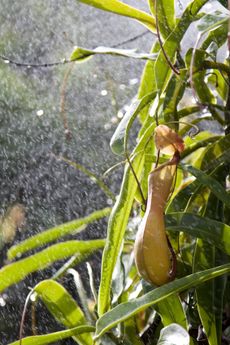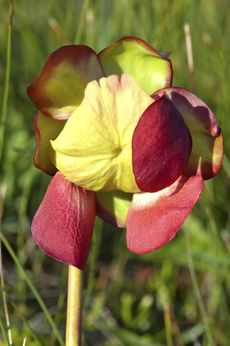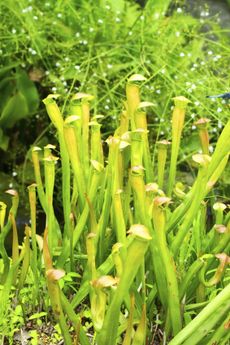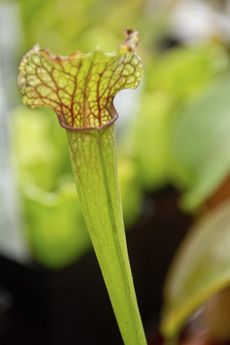Hanging Pitcher Plant Care: Types Of Pitcher Plants For Hanging Baskets


Pitcher plants are a fantastic addition to the home. They’re a little bit temperamental, but if you’re willing to put in the extra work, you’ll have a striking conversation piece. Keep reading to learn about good pitcher plants for hanging baskets.
Hanging Pitcher Plant Care
Hanging pitcher plants in baskets is the most effective way to grow them. In the wild, the plants vine up trees, and providing them with plenty of empty space will give them the air circulation they crave and allow the pitchers to grow to their full and most impressive extent. Hanging pitcher plants thrive in light, well-draining soil that’s poor in nutrients but high in organic matter. This can be sphagnum moss, coconut fiber, or a store-bought orchid mix. Pitcher plants need high humidity-- water frequently from above and mist daily. Hang your basket somewhere it can receive full sun. Temperature is very important. Most species require daytime temperatures of 80 degrees F. (26 C.) and higher, with a very marked temperature drop at night.
Pitcher Plants for Hanging Baskets
Pitcher plants are native to southeast Asia and northern Australia and, for the most part, crave high temperatures and humid air. Many varieties, however, grow at high elevations and are used to much cooler temperatures. Pitcher plants cross pollinate very easily and, as such, there are a huge number of varieties and quite a few that are able to tolerate low temperatures.
- Nepenthes khasiana is a species that’s a good choice for beginners. It’s extremely hardy as pitcher plants go, with a tolerance range of 38 to 105 degrees F. (3-40 C.).
- Nepenthes stenophylla can tolerate a narrower but still wide range of temperatures from 50 to 98 degrees F. (10-36 C.).
If you live in a hot area or have a greenhouse, however, your options are much greater.
- Nepenthes alata is easy to care for and forms bright red pitchers that can reach 7 inches (18 cm.) in length.
- Nepenthes eymae produces wide, red speckled pitchers low on the plant and small green pitchers higher up, making for a nice, diverse look.
The number of species is enormous, however, so first get a sense of your area’s temperature range and then look into what’s available.
Gardening tips, videos, info and more delivered right to your inbox!
Sign up for the Gardening Know How newsletter today and receive a free download of our most popular eBook "How to Grow Delicious Tomatoes."

The only child of a horticulturist and an English teacher, Liz Baessler was destined to become a gardening editor. She has been with Gardening Know how since 2015, and a Senior Editor since 2020. She holds a BA in English from Brandeis University and an MA in English from the University of Geneva, Switzerland. After years of gardening in containers and community garden plots, she finally has a backyard of her own, which she is systematically filling with vegetables and flowers.
-
 10 Best Apartment Plants To Turn Your Small Space Into An Oasis
10 Best Apartment Plants To Turn Your Small Space Into An OasisThe best apartment plants can lend an ambience of the tropics, brighten up a space, or add a touch of drama, and turn an apartment into a relaxing oasis.
By Amy Grant
-
 Grow a Bathroom Oasis: 8 Best Bathroom Plants With No Light or Low Light
Grow a Bathroom Oasis: 8 Best Bathroom Plants With No Light or Low LightSome apartment dwellers grow the best bathroom plants with no light or low light. Read how one of our favorite plant lovers does it in the big city.
By Teo Spengler
-
 Black Pitcher Plant Leaves – Why Nepenthes Leaves Are Turning Black
Black Pitcher Plant Leaves – Why Nepenthes Leaves Are Turning BlackPitcher plant has specific needs, and it lets you know with alarming clarity when those needs aren't being met. This article explains what to do when you find your pitcher plant's leaves turning black. Click here to learn more.
By Jackie Carroll
-
 Watering Nepenthes – How To Water A Pitcher Plant
Watering Nepenthes – How To Water A Pitcher PlantThere are many types of exotic pitcher plants, all surprisingly easy to grow once you learn how to meet the plant's basic needs, including proper pitcher plant watering. Click here to learn what's involved in watering a pitcher plant.
By Mary H. Dyer
-
 Nepenthes Pitcher Plants: Treating A Pitcher Plant With Red Leaves
Nepenthes Pitcher Plants: Treating A Pitcher Plant With Red LeavesNepenthes pitcher plants are often grown as houseplants. If you own one, you may see your pitcher plant leaves turning red. There are various possible reasons for a pitcher plant with red leaves; some require fixing, some do not. Click here to learn more.
By Teo Spengler
-
 Pitcher Plant Pest Control: Learn About Pests Of Pitcher Plants
Pitcher Plant Pest Control: Learn About Pests Of Pitcher PlantsPitcher plants are exotic, fascinating plants, but they're prone to many of the same problems that affect any other plant, including pests. If you're wondering how to get rid of bugs on carnivorous plants, it can be tricky. Click here to find out why.
By Mary H. Dyer
-
 Do Pitcher Plants Bloom: Learn About Pitcher Plant Flowers
Do Pitcher Plants Bloom: Learn About Pitcher Plant FlowersDo pitcher plants bloom? They certainly do, and pitcher plant flowers are just as fascinating as the colorful, mysterious pitchers. Click on this article for more pitcher plant flower information. You'll be amazed at how lovely their flowers are.
By Mary H. Dyer
-
 Pitcher Plant Info: Growing Pitcher Plants In The Garden
Pitcher Plant Info: Growing Pitcher Plants In The GardenGrowing pitcher plants outdoors requires a combination of conditions quite different from ordinary garden plants. To learn what these plants need to grow outdoors, click on the article that follows for additional information.
By Karen Boness
-
 Carnivorous Plant Problems: Why A Pitcher Plant Has No Pitchers
Carnivorous Plant Problems: Why A Pitcher Plant Has No PitchersIf you're having carnivorous plant problems, such as a pitcher plant not making pitchers, it may require some troubleshooting to determine the problem. For helpful tips on this issue, simply click on the following article.
By Mary H. Dyer
-
 Pitcher Plant Seeds: Guide To Pitcher Plant Seed Growing
Pitcher Plant Seeds: Guide To Pitcher Plant Seed GrowingPitcher plant seed sowing is one of the best ways to reproduce this beautiful plant. But like the seeds of other carnivorous plants, they need special treatment to give them their best chance of growing. Click this article to learn more.
By Teo Spengler